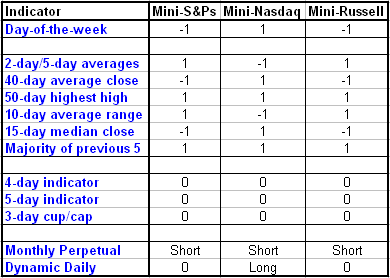Sometimes it's good to backtrack a bit.
We've broken calendar months into two parts creating optimal time frames for being long and short in the indexes. (Be long from the 22nd through the following 6th, and initiate shorts on the 7th and hold them through the 21st.) We've hinted that this time frame is robust enough to allow variations on the idea, including day trades. We already demonstrated the effectiveness of buying lower openings and selling higher ones in line with the time frames.
What about day trades without any adornments at all? Can we go short every day in the mid-month period and long around the monthly turnovers as the dates dictate? Probably, as Figure 1 demonstrates. This is a 5-year record (through May 14) of entering on the open, exiting on the close every day according to the monthly indicator.

You can see the statistically significant volume of trades and the encouraging net profits across the board. As usual, we're leaving slippage/commission out of this, meaning that we would have to do a little additional math if we were actually going to trade this way. Two out of four of the contracts, however, did yield more profit per trade than the customary $100 slippage commission penalty we'd expect.
It doesn't take a lot of extrapolation to figure that we can filter and qualify our way to better results. (We already have with our “fade-the-open” idea.) Tomorrow we'll look at something else that works. Stay tuned.
The Biases
The daily indicators in both the S&Ps and Russell have turned neutral, therefore, switch positions from long to short in line with the monthly. Continue to hold Nasdaq longs, as the daily remains bullish.
The bottom two rows determine the signal. Dynamic Day One trumps everythingâ€"you always follow it. When it's neutral, the Monthly Perpetual provides the direction. Click here for a more in-depth explanation of the rules.

DISCLAIMER: It should not be assumed that the methods, techniques, or indicators presented on in this column will be profitable or that they will not result in losses. Past results are not necessarily indicative of future results. Examples presented on this column are for educational purposes only. These set-ups are not solicitations of any order to buy or sell. The author, Tiger Shark Publishing LLC, and all affiliates assume no responsibility for your trading results. There is a high degree of risk in trading.
Art Collins is the author of Market Beaters, a collection of interviews with renowned mechanical traders. He is currently working on a second volume. E-mail Art at artcollins@ameritech.net.